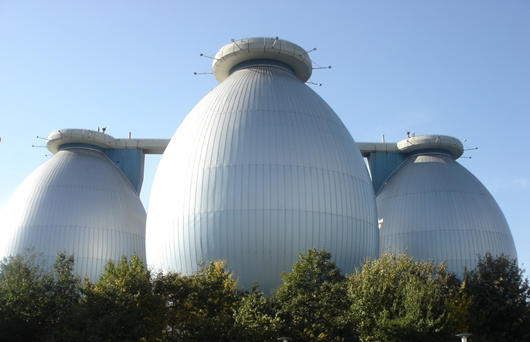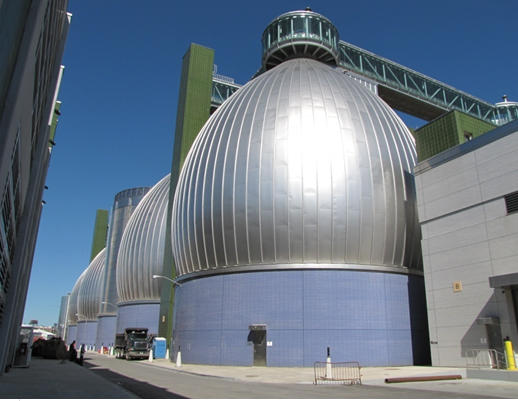Wastewater Treatment
ระบบบำบัดน้ำเสีย ระบบกำจัดไขมัน และน้ำมัน ระบบบำบัดน้ำเสียด้วยวิธีทางเคมี (Chemical Treatment System) ระบบบำบัดน้ำเสียด้วยวิธีทางชีวภาพ (Biological Treatment System)
Digestor
Anaerobic digestion is a series of processes in which microorganisms break down biodegradable material in the absence of oxygen, used for industrial or domestic purposes to manage waste and/or to release energy.
It is widely used as part of the process to treat wastewater[1]. As part of an integrated waste management system, anaerobic digestion reduces the emission of landfill gas into the atmosphere.
Anaerobic digestion is widely used as a renewable energy source because the process produces a methane and carbon dioxide rich biogas suitable for energy production, helping to replace fossil fuels. The nutrient-rich digestate which is also produced can be used as fertilizer. The digestion process begins with bacterial hydrolysis of the input materials in order to break down insoluble organic polymers such as carbohydrates and make them available for other bacteria. Acidogenic bacteria then convert the sugars and amino acids into carbon dioxide, hydrogen, ammonia, and organic acids. Acetogenic bacteria then convert these resulting organic acids into acetic acid, along with additional ammonia, hydrogen, and carbon dioxide. Finally, methanogens convert these products to methane and carbon dioxide.[2] The technical expertise required to maintain industrial scale anaerobic digesters coupled with high capital costs and low process efficiencies had limited the level of its industrial application as a waste treatment technology.[3] Anaerobic digestion facilities have, however, been recognized by the United Nations Development Programme as one of the most useful decentralized sources of energy supply, as they are less capital intensive than large power plants.
Anaerobic digestion of animal waste is the primary cause of odors, solids build up and many diseases in swine, dairy and poultry facilities, processing plants, municipal waste systems and septic systems. Animal waste concentrated in pits under slatted floors or collected in holding tanks or lagoons has the natural tendency to “go anaerobic”. Anaerobic digestion occurs when the anaerobic microbes are dominant over the aerobic microbes. Anaerobic microbes will naturally become dominant in pits or lagoons because of the lack of oxygen in solutions containing heavy concentrations of animal waste, which results in a high biological oxygen demand (BOD). These microbes feed on the animal waste at the bottom of the pits and lagoons. As they digest waste, large amounts of toxic gases are released due to the digestion processes common to the anaerobic microbes.
The predominate toxic gases produced by anaerobic digestion are hydrogen sulfide and ammonia. These gases can contribute to pneumonia and other diseases among confined animals. Production costs are increased due to sick and/or dead animals due to the conditions produced by the anaerobic digestion of the animal waste. Anaerobic microbes digest waste solids very slowly leading to the buildup of solids and pungent toxic gases in the pits and lagoons. This reduces the efficiency of waste management systems.
The anaerobic digestion of animal waste can be changed to aerobic digestion by proper applications of Natural Enviro 6000 Animal Waste and Odor Control into the effluent stream of most animal waste systems. Natural Enviro 6000 contains a very broad and diverse population of beneficial aerobic microbes in a highly concentrated form. Aerobics require an oxygen-containing environment. If aerobic microbes are introduced into an environment that is lacking oxygen they will begin to build oxygen into this environment as long as they survive and reproduce. Aerobes have the ability to do this in a liquid media or in the soil as long as there is an adequate moisture and food source for them to feed on and reproduce.
Once the aerobic microbes become dominant, the aerobic digestion of waste begins. Aerobic, unlike anaerobic digestion, does not produce the pungent gases. The aerobic process results in a more complete digestion of waste solids reducing the buildup in pits and lagoons by more than 50% in most cases. The aerobic process also improves the environment of the workers and the animals and helps to keep pathogens in check. With proper application of Natural Enviro 6000, the anaerobic process is converted to aerobic and overall production cost will be reduced.





